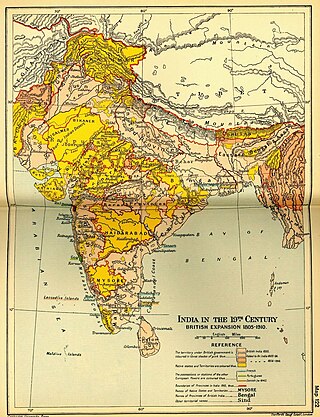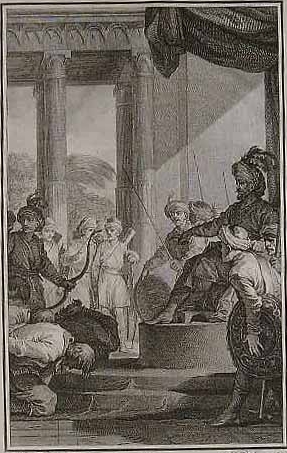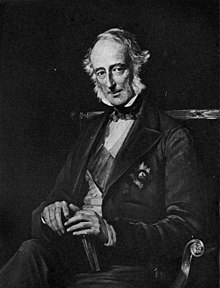
Warren Hastings was a British colonial administrator, who served as the first Governor of the Presidency of Fort William (Bengal), the head of the Supreme Council of Bengal, and so the first Governor-General of Bengal in 1772–1785. He and Robert Clive are credited with laying the foundation of the British Empire in India. He was an energetic organizer and reformer. In 1779–1784 he led forces of the East India Company against a coalition of native states and the French. In the end, the well-organized British side held its own, while France lost influence in India. In 1787, he was accused of corruption and impeached, but he was eventually acquitted in 1795 after a long trial. He was made a Privy Councillor in 1814.

Company rule in India was the rule of the British East India Company on the Indian subcontinent. This is variously taken to have commenced in 1757, after the Battle of Plassey, when the Nawab of Bengal Siraj ud-Daulah was defeated and replaced with Mir Jafar, who had the support of the East India Company; or in 1765, when the Company was granted the diwani, or the right to collect revenue, in Bengal and Bihar; or in 1773, when the Company abolished local rule (Nizamat) in Bengal and established a capital in Calcutta, appointed its first Governor-General, Warren Hastings, and became directly involved in governance. The Company ruled until 1858, when, after the Indian Rebellion of 1857 and the Government of India Act 1858, the India Office of the British government assumed the task of directly administering India in the new British Raj.

Charles Wood, 1st Viscount Halifax, known as Sir Charles Wood, 3rd Baronet, between 1846 and 1866, was a British Whig politician and Member of the British Parliament. He served as Chancellor of the Exchequer from 1846 to 1852.

The University of Calcutta is a public state university located in Kolkata, West Bengal, India. It has 151 affiliated undergraduate colleges and 16 institutes in Kolkata and nearby areas. It was established on 24 January 1857 and is the oldest multidisciplinary university of Indian Subcontinent and South East Asian Region. Today, the university's jurisdiction is limited to a few districts of West Bengal, but at the time of its establishment it had a catchment area ranging from Kabul to Myanmar. Within India, it is recognized as a "Five-Star University" and accredited an "A" grade by the National Assessment and Accreditation Council (NAAC).
Events in the year 1857 in India.
The renaming of the cities in India started in 1947 CE following the end of the British imperial period. Several changes were controversial, and not all proposed changes were implemented. Each had to be approved by Government of India in Delhi.

The Madras Presidency or Madras Province, officially called the Presidency of Fort St. George until 1937, was an administrative subdivision (province) of British India and later the Dominion of India. At its greatest extent, the presidency included most of southern India, including all of present-day Andhra Pradesh, almost all of Tamil Nadu and parts of Kerala, Karnataka, Odisha and Telangana in the modern day. The city of Madras was the winter capital of the presidency and Ooty was the summer capital.
South Asian English is the English accent of many modern-day South Asian countries, inherited from British English dialect. Also known as Anglo-Indian English during the British Raj, the English language was introduced to the Indian subcontinent in the early 17th century and reinforced by the long rule of the British Empire. Today it is spoken as a second language by about 350 million people, 20% of the total population.

The Bombay Presidency or Bombay Province, also called Bombay and Sind (1843–1936), was an administrative subdivision (province) of British India and later the Dominion of India, with its capital in the city that came up over the seven islands of Bombay. The first mainland territory was acquired in the Konkan region with the Treaty of Bassein (1802). Poona was the summer capital.

The provinces of India, earlier presidencies of British India and still earlier, presidency towns, were the administrative divisions of British governance on the Indian subcontinent. Collectively, they have been called British India. In one form or another, they existed between 1612 and 1947, conventionally divided into three historical periods:
Madras Time was a time zone established in 1802 by John Goldingham, the first official astronomer of the British East India Company in British India when he determined the longitude of Madras as 5 hours, 21 minutes and 14 seconds ahead of Greenwich Mean Time. It has been described as 8 minutes and 46 seconds from UTC+05:30 and 32 minutes and 6 seconds behind Calcutta Time which puts it at (UTC+05:21:14). Before India's independence, it was the closest precursor to Indian Standard Time which is derived from the location of the observatory at 82.5°E longitude in Shankargarh Allahabad in Uttar Pradesh.

Education in the Indian subcontinent began with teaching of traditional elements such as Indian religions, Indian mathematics, Indian logic at early Hindu and Buddhist centres of learning such as ancient Takshashila and Nalanda. Islamic education became ingrained with the establishment of Islamic empires in the Indian subcontinent in the Middle Ages while the coming of the Europeans later brought western education to colonial India.

The presidency armies were the armies of the three presidencies of the East India Company's rule in India, later the forces of the British Crown in India, composed primarily of Indian sepoys. The presidency armies were named after the presidencies: the Bengal Army, the Madras Army and the Bombay Army. Initially, only Europeans served as commissioned or non-commissioned officers. In time, Indian Army units were garrisoned from Peshawar in the north, to Sind in the west, and to Rangoon in the east. The army was engaged in the wars to extend British control in India and beyond.

Coinage under British governance of the Indian subcontinent can be divided into two periods: East India Company (EIC) issues, pre-1835; and Imperial issues struck under direct authority of the crown. The EIC issues can be further subdivided into two subcategories: the Presidency issues, which comprise separate Madras Presidency, Bombay Presidency, and Bengal Presidency issues; and uniform coinage for all British territories from 1835 to 1858. Imperial issues bear obverse portraits of Queen Victoria, Edward VII, George V, and George VI. No British India coins were issued during the brief reign of Edward VIII.

The Anglo-Mughal war, also known as Child's war, was the first Anglo-Indian war on the Indian subcontinent.
Scottish-Indians are Indian citizens of mixed Indian and Scots ancestry or people of Scottish descent born or living in India. Like Irish Indians, a Scottish-Indian can be categorized as an Anglo-Indian. Scottish Indians celebrate Scottish culture, with traditional Scottish celebrations like Burns Night widely observed among the community.

Muir Central College in Prayagraj in northern India was a college of higher education founded by William Muir in 1872. It had a separate existence to 1921, when as a result of the Allahabad University Act it was merged into University of Allahabad.
Events in the year 1867 in India.

The Church Missionary Society in India was a branch organisation established by the Church Missionary Society (CMS), which was founded in Britain in 1799 under the name the Society for Missions to Africa and the East, as a mission society working with the Anglican Communion, other Protestants, and Orthodox Christians around the world. In 1812, the British organization was renamed the Church Missionary Society.
General Morden Carthew CB was an officer in the service of the East India Company (E.I.C.) Indian Army in the Madras Presidency, India and South East Asia during the mid 19th century.












